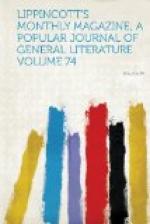But all these employments were as play compared with the home manufacture of dry goods. Ralph, Jack and Jim had no time for such work, so two other men were all winter kept busy in the barn at “crackling flax” and afterward passing it through a coarse hetchel to separate the coarsest or “swingling tow.” After this the flax was made up into switches or “heads” like those which we see in pictures, or that which Faust’s Marguerite so temptingly wields. These were deposited in barrels in the garret. During the winter the “heads” were brought down by the women to be rehetcheled once and again, removing first the coarser, and then the finer tow. This must have been a fearfully dusty operation. It makes one cough only to think of “the inch depth of flax-dust” which settled upon Betsey’s protecting handkerchief while she “hetcheled.”
The finest and best of the flax was saved for spinning into thread, for cotton thread there was none, excepting, possibly, a little of very poor quality in small skeins. The small wheel that we see in the far corner of the garret—just like Marguerite’s—was used for spinning the fine thread. A larger wheel was used to spin the tow into yarn for the coarse clothing for boys and negroes or for “filling” in the coarser linens. All the boys, and very often the men—perhaps even our M.C. himself—wore in summer trousers made of linen cloth, for which the yarn was spun at home by the maids, and was then taken to the weaver’s to be made into cloth. Part of the linen yarn was dyed blue, and, mingled with white or unbleached yarn, was woven into a chequered stuff for the curtains of servants’ beds and for dresses for the maids and aprons for their mistresses. In view of the fact that all the bed-linen and most of the table-linen was thus made at home, one cannot wonder that a house-wife’s linen-closet was an object of special care and pride.




